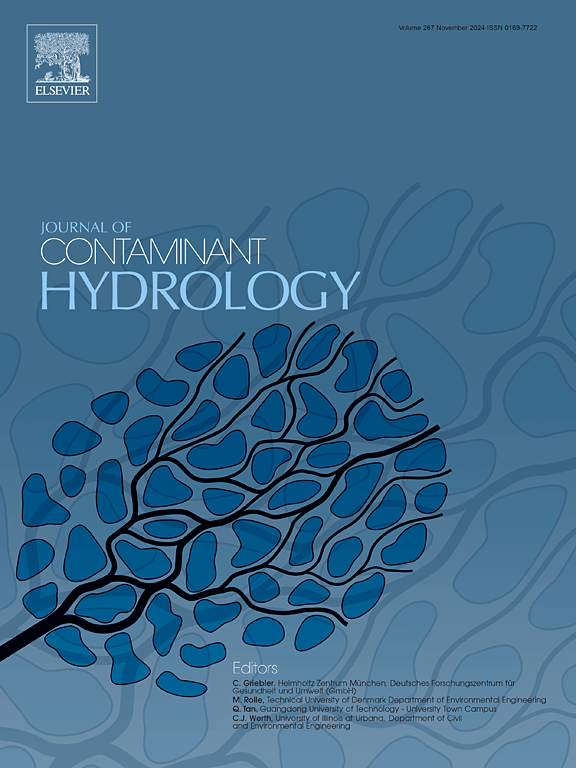A green approach: Utilizing untreated pine pollen grains as a natural biosorbent for microplastic removal from water systems
IF 3.5
3区 环境科学与生态学
Q2 ENVIRONMENTAL SCIENCES
引用次数: 0
Abstract
Microplastics (MPs) are widespread pollutants that pose significant threats to aquatic ecosystems and human health. This study evaluates the potential of untreated pine (Pinus eldarica) pollen grains as an eco-friendly, chemical-free biosorbent for removing MPs from water. The heterogeneous and porous surface of pine pollen, enriched with functional groups, enables effective adsorption of MPs through electrostatic and hydrophobic interactions. Untreated pine pollen achieved a maximum removal efficiency of 66.2±2.54% for polystyrene (PS) MPs at a pollen concentration of 240 mg/L and with higher efficiencies of 87% for PVC (Polyvinyl Chloride) and 95.2% for PET (Polyethylene Terephthalate), reflecting differences in polymer hydrophobicity and density. Adsorption followed the Freundlich isotherm model (R2=0.977), suggesting heterogeneous binding sites, and removal efficiency for PS MPs was size-dependent, decreasing from approximately 78% for 75−150 μm particles to approximately 63% for 250−500 μm particles. Alkaline pH enhanced PS MP removal to 77.6±3.39%, while the presence of humic acid (15 mg/L) reduced efficiency to approximately 56%, and competitive anions, particularly H₂PO₄− (5 mM), decreased it further to 45.2±1.7%. Surfactants significantly improved MP removal; for instance, non-ionic Tween20 increased efficiency from the baseline 66.2% to approximately 98%, and cationic CTAB to approximately 94%. Pine pollen showed strong reusability, maintaining over 50% removal efficiency for PS MPs after four adsorption-desorption cycles. It also maintained effectiveness in real water samples, achieving approximately 59% removal in lake water, though performance decreased to around 45% in wastewater. These findings highlight untreated pine pollen as a natural, cost-effective, and sustainable alternative to chemical agents for mitigating MP pollution in aquatic environments.

绿色方法:利用未经处理的松花粉粒作为天然生物吸附剂,从水系统中去除微塑料
微塑料是一种广泛存在的污染物,对水生生态系统和人类健康构成重大威胁。本研究评估了未经处理的松(Pinus eldarica)花粉粒作为一种生态友好、无化学物质的生物吸附剂去除水中MPs的潜力。松花粉的多相多孔表面富含官能团,可通过静电和疏水相互作用有效吸附MPs。当花粉浓度为240 mg/L时,未处理松花粉对聚苯乙烯(PS) MPs的去除率最高为66.2±2.54%,对聚氯乙烯(PVC)的去除率最高为87%,对聚对苯二甲酸乙二醇酯(PET)的去除率最高为95.2%,这反映了聚合物疏水性和密度的差异。吸附符合Freundlich等温线模型(R2=0.977),表明PS - MPs的结合位点呈非均匀性,去除效率与粒径有关,75 ~ 150 μm颗粒的去除效率约为78%,250 ~ 500 μm颗粒的去除效率约为63%。碱性pH使PS MP去除率提高到77.6±3.39%,而腐植酸(15 mg/L)的存在使去除率降低到约56%,竞争阴离子,特别是H₂PO₄−(5 mM),使去除率进一步降低到45.2±1.7%。表面活性剂显著改善MP的去除;例如,非离子Tween20将效率从基线的66.2%提高到约98%,阳离子CTAB将效率提高到约94%。松花粉具有较强的可重复使用性,经过4次吸附-解吸循环后,对PS - MPs的去除率保持在50%以上。它在实际水样中也保持了有效性,在湖水中去除率约为59%,但在废水中去除率降至45%左右。这些发现突出表明,未经处理的松花粉是一种天然的、具有成本效益的、可持续的化学试剂替代品,可减轻水生环境中的多聚甲醛污染。
本文章由计算机程序翻译,如有差异,请以英文原文为准。
求助全文
约1分钟内获得全文
求助全文
来源期刊

Journal of contaminant hydrology
环境科学-地球科学综合
CiteScore
6.80
自引率
2.80%
发文量
129
审稿时长
68 days
期刊介绍:
The Journal of Contaminant Hydrology is an international journal publishing scientific articles pertaining to the contamination of subsurface water resources. Emphasis is placed on investigations of the physical, chemical, and biological processes influencing the behavior and fate of organic and inorganic contaminants in the unsaturated (vadose) and saturated (groundwater) zones, as well as at groundwater-surface water interfaces. The ecological impacts of contaminants transported both from and to aquifers are of interest. Articles on contamination of surface water only, without a link to groundwater, are out of the scope. Broad latitude is allowed in identifying contaminants of interest, and include legacy and emerging pollutants, nutrients, nanoparticles, pathogenic microorganisms (e.g., bacteria, viruses, protozoa), microplastics, and various constituents associated with energy production (e.g., methane, carbon dioxide, hydrogen sulfide).
The journal''s scope embraces a wide range of topics including: experimental investigations of contaminant sorption, diffusion, transformation, volatilization and transport in the surface and subsurface; characterization of soil and aquifer properties only as they influence contaminant behavior; development and testing of mathematical models of contaminant behaviour; innovative techniques for restoration of contaminated sites; development of new tools or techniques for monitoring the extent of soil and groundwater contamination; transformation of contaminants in the hyporheic zone; effects of contaminants traversing the hyporheic zone on surface water and groundwater ecosystems; subsurface carbon sequestration and/or turnover; and migration of fluids associated with energy production into groundwater.
 求助内容:
求助内容: 应助结果提醒方式:
应助结果提醒方式:


